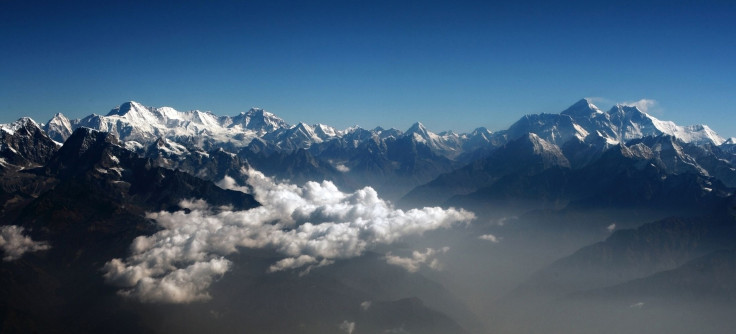Space Travel to Mars Without Leaving Earth: 9 Places On The Planet That Are Like Mars

It will be a while before the average human can take a trip to Mars, whether it be for business or pleasure. But the wait could be agony for all the people who are obsessed with the Red Planet. Until the technology catches up with our ambitions, a few places right here on Earth can serve as substitutes, because they have something in common with our outward solar system neighbor.

Mount Everest
Earth’s air pressure at sea level is about 14.7 pounds of pressure per square inch of space, a unit abbreviated as psi. Air pressure has to do with the weight of the atmosphere, and a lower weight means the molecules we need to breathe are more spaced out, which makes it harder to sustain ourselves. On Mars, the air pressure is a fraction of what it is here — less than a tenth of a pound of pressure per square inch. If you’re looking to replicate the nearly non-existent air pressure on Mars, the highest peak on Earth might be your best bet. It’s no match for a trip to the topmost layer of our planet’s atmosphere, the exosphere, where the air is as thin as it gets while still technically staying on Earth, but climbing Mount Everest allows you to experience thinner air without taking your feet off the ground. Still, at a little less than 5 psi, it is difficult to breathe at the Everest summit but is nothing compared to the struggle on the surface of Mars.
Read: A Little Friend for the Mars Rover
Lonely places
One main feature of living on Mars is isolation — there aren’t any humans roaming there right now, and at least in the beginning of human exploration on the planet there won’t be very many. If we colonize it, the first people to take the trip are going to have to be able to handle living in a remote place, without a lot of neighbors. A few places on Earth offer a similar environment, such as Point Nemo, the spot on Earth that is the farthest you can get from land. If that isn’t practical enough, you can try Hum in northwestern Croatia, which has a population of fewer than two dozen people, or Svalbard, a group of Norwegian islands between the mainland and the North Pole that is the world’s northernmost full-time settlement. That Arctic Ocean destination has a significantly higher population though, of more than 2,000.
Simpson Desert
Mars is a little rusty — it’s famous for its red color, which comes from all the iron oxide in the soil. Although its landscape is dotted with grasses and other plant life, some parts of the Simpson Desert in Australia share that redness with Mars. Live Science explains that the sand turns red because hematite, a mineral form of iron oxide, builds up on the grains over time.

Antarctica
Temperatures on Mars have gone as high as 86 degrees Fahrenheit, but the surface has also dipped as low as -190 degrees. You read that correctly — the low end of the temperature range is so far into the negatives that it’s almost the opposite of the heat it takes to boil water. A trip to Antarctica could replicate some of the chill of Mars. On the frozen landscape capping the bottom of Earth, the average temperature is -30 degrees Fahrenheit. That sounds balmy compared to the Red Planet but it once dipped as low as -129 degrees, so if you use a weather forecast to plan your trip properly, you may get even closer to Mars.
Read: Supermassive Black Hole Farts Out Baby Star
Lake Nyos
There isn’t a lot of oxygen on Mars — according to NASA data, in fact, the thin atmosphere is overwhelmingly composed of carbon dioxide. Residents near Lake Nyos in Cameroon are managing the body of water for now, but it is a dangerous place because “a pocket of magma deep below the lake bed leaks carbon dioxide into the lake above,” Live Science says, comparing the water to a carbonated beverage. But during the lake’s history, the carbon dioxide has exploded upward and out of the lake, sending a noxious cloud of carbon dioxide into the surrounding area. “In the 15 miles (24 kilometers) of valleys below the lake, almost nothing survived,” and that included humans.
Mojave Desert
NASA has already used this desert in the American southwest to train scientists in how they would take surveys and samples and perform other tests during a theoretical trip to Mars. “The Mojave’s inhospitable, sun-scorched environment presents scientists with perfect opportunities to study locations that are similar to what explorers would find on the Moon or Mars,” NASA has explained.
Kīlauea
NASA describes the surface of Mars as “rocky, with canyons, volcanoes, dry lake beds and craters all over it.” Although the volcanoes on Mars are much larger than the ones here on Earth, scientists can learn a lot about our planetary neighbor by studying them. Kīlauea in Hawaii is one of the most active volcanoes in the world.
See also:
Special Lava Makes This Spot on the Moon Look Younger
All the Garbage Orbiting Earth Threatens Future Space Travel
© Copyright IBTimes 2024. All rights reserved.





















